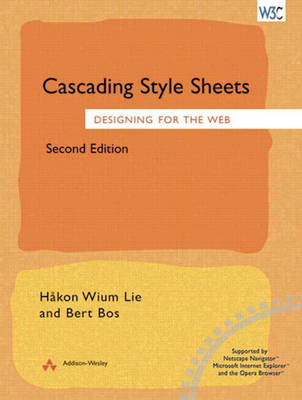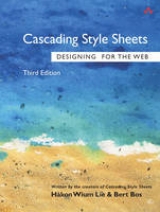
Cascading Style Sheets:Designing for the Web
Addison-Wesley Professional (Verlag)
978-0-201-59625-0 (ISBN)
- Titel erscheint in neuer Auflage
- Artikel merken
Cascading Style Sheets (CSS) is a standard that provides an easy and manageable way to add style and layout to Web pages. The World Wide Web Consortium (W3C) developed it as a companion to HTML and XML. Written by the inventors of CSS, this book contains tutorials on CSS, HTML and XML with simple examples and makeover documents as well as detailed information on both CSS level 1 and 2. It is the perfect introduction to CSS for beginning writers of Web pages, and the definitive guide for professional Web designers.
Hkon Wium Lie is a product of the MIT Media Lab's Electronic Publishing Group, who joined the WWW project at CERN Physics Laboratory in Geneva in the early days of the Web. He first proposed the concept of Cascading Style Sheets in 1994 and is now responsible for Style Sheets within W3C. When not working on how to beautify web pages, he paints 'Rothko'-like paintings and collects bits and pieces for his soon to be built, computer controlled pipe organ. Bert Bos completed his Ph.D in Groningen, The Netherlands, on a prototyping language for graphical user interfaces. He developed browser software and support for humanities scholars and then joined the W3C at INRIA/Sophia-Antipolis in 1995. He started, and for three years led, W3C's work on internationalization, and now coordinates the development of new versions of XML. He continues his work on Style Sheets.
Chapter 1: The Web and HTML The Web Markup Languages Dodging the Limitations of HTML HTML Basics Document Trees Chapter 2: CSS 30 Rules and Style Sheets "Gluing" Style Sheets to the Document Browsers and CSS Tree structures and inheritance Overriding Inheritance Properties that don't inherit Common tasks with CSS A word about Cascading Chapter 3: The Amazing EM Unit and Other Best Practices Chapter 4: CSS Selectors Selector Schemes Type Selectors Simple attribute selectors The STYLE Attribute Combining Selector Types Simple contextual selectors External information: pseudo-classes and pseudo-elements DIV and SPAN Advanced attribute selectors Advanced contextual selectors Advanced pseudo-classes Advanced pseudo-elements The "any" selector Chapter 5: Fonts Typesetting terminology Classifying font families The font-family property Font metrics Length units Percentages as values The font-size property The font-style property The font-variant property The font-weight property The font property The font-stretch property Numbers as values The font-size adjust property The text-decoration property The text-transform property More information about fonts Chapter 6: WebFonts Prerequisites for WebFonts Font Descriptions Font Descriptors Basic font descriptors Resource descriptors The Unicode-range descriptor Matching descriptors Synthesis descriptors Alignment descriptors Chapter 7: The Fundamental Objects The box model The display property Creating side-heads Achieving different effects More about lists - the list-style properties The list-style-type property The list-style-image property The list-style-position property The list-style property Generated text, counters and quotes The white-space property Chapter 8: Space Inside Boxes Space inside Block-Level Elements The text-align property Right aligning text Justifying text The text-indent property Using the text-indent property The line-height property Using the line-height property The word-spacing property Using word spacing The letter-spacing property The vertical-align property Chapter 9: Space Around Boxes Margins and the margin properties Using the margin property Common usages of the margin properties The padding properties The border properties group The border-color properties The border-style properties The border-width properties Using the border-width properties The border properties Using the border properties Working with the border properties Outline borders Collapsing margins The width property The height property The clear property Minimum and maximum widths and heights The whole story on width computation "Case 1: no value is "auto" Case 2: one value is "auto" Case 3: two or three of the three values are "auto" "Overflow Chapter 10: Relative and Absolute Positioning The position property The containing block Relative positioning Fixed positioning Absolute positioning The z-index property Making elements invisible Chapter 11: Colors Specifying colors The properties Setting the color of a border Setting the color of hyperlinks The background properties The background color property The background image property The background repeat property The background attachment property The background position property The background property Setting the background of the canvas Shadows Chapter 12: Printing and Other Media Page breaks Page areas Media-specific style sheets Chapter 13: Aural Style Sheets Introduction to aural style sheets Volume properties: volume Speaking properties: speak Pause properties: pause-before, pause-after, and pause Cue properties: cue-before, cue-after, and cue Mixing properties: play during Spatial properties: azimuth and elevation Voice characteristic properties: speech-rate, voice-family, pitch, pitch-range, stress, and richness Speech properties: speak-punctuation and speak-numeral Chapter 14: From HTML Extensions to CSS "Case 1: Magnet Case 2: Cyberspazio Case 3: "The form of the book" Case 4: "The new typography" Case 5: TSDesign "Chapter 15: Cascading and Inheritance Example 1: The Basics Example 2: conflicts appear Example 3: accommodating user styles Example 4: a more complex example The "inherit" keyword Chapter 16: External Style Sheets Why external style sheets? External HTML style sheets Linking to style sheets External XML style sheets W3C Core styles Chapter 17: Other Approaches Creating a document without using a style sheet Using a different format from HTML Using XSL Chapter 18: XML Documents Experimenting with XML Some examples Chapter 19: Tables The parts of a table The collapsing borders model The separated borders model Alignment Sizes Setting background colors "Collapsing" columns and rows Inline tables XML and tables Chapter 20: The CSS Saga Browsers "Appendix A: HTML 4.0 Quick Reference "Document structure The HEAD element The BODY element Text-level elements Special characters "Appendix B: Reading Property Value Definitions "Multiple values Tying it all together "Appendix C: System Colors: " Index
| Erscheint lt. Verlag | 16.7.1999 |
|---|---|
| Sprache | englisch |
| Maße | 186 x 245 mm |
| Gewicht | 648 g |
| Themenwelt | Mathematik / Informatik ► Informatik ► Web / Internet |
| ISBN-10 | 0-201-59625-3 / 0201596253 |
| ISBN-13 | 978-0-201-59625-0 / 9780201596250 |
| Zustand | Neuware |
| Haben Sie eine Frage zum Produkt? |
aus dem Bereich



